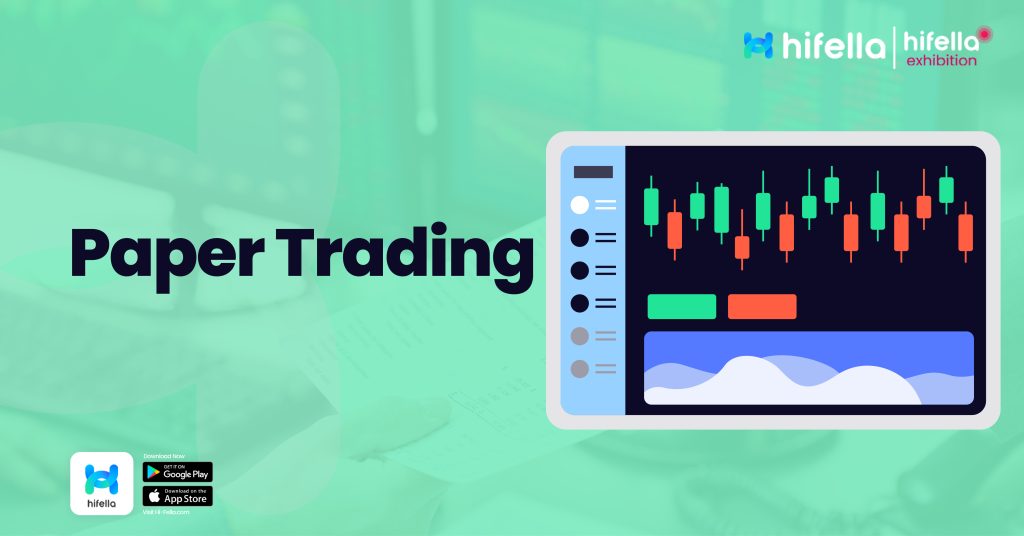Before diving into the world of real trading, it’s crucial to build a solid foundation. Many new traders jump into the markets without fully understanding how things work, leading to costly mistakes. This is where paper trading comes in.
By simulating the trading experience with virtual money, paper trading offers a risk-free way to learn the ropes, develop strategies, and gain confidence.
Whether you’re a beginner just getting started or an experienced trader looking to fine-tune your skills, paper trading is an essential step in your journey to becoming a successful trader.
What is Paper Trading?

Source: MTrading
Paper trading is like playing a trading game, but instead of using real money, you use pretend money. It’s a way to practice buying and selling stocks, cryptocurrencies, or other financial assets without risking any real cash.
This practice is great for beginners who are just starting to learn about trading or for experienced traders who want to try out new strategies in a safe environment.
Why Paper Trading is Perfect for New Traders
Starting out in the world of trading can be intimidating, especially with the risk of losing real money. For new traders, the fear of making mistakes often holds them back from exploring the full potential of trading. This is where paper trading becomes invaluable. It offers a safe and supportive environment to learn, practice, and build the confidence needed to succeed in the real markets.
Let’s explore why paper trading is the ideal tool for beginners looking to get a strong start in their trading journey.
1. Learn Without Worrying About Losing Money
One of the best things about paper trading is that you can learn how trading works without the fear of losing your money. Since you’re using fake money, you can make mistakes, experiment with different strategies, and learn from your experiences without any financial consequences.
2. Build Confidence in Your Trading Skills
Paper trading helps you get comfortable with the trading process. By making trades and seeing how your decisions play out, you’ll gain confidence. This confidence is essential when you eventually start trading with real money.
3. Understand How Markets Work
When you paper trade, you get to see how the market moves in real-time. You can learn about price changes, how to place different types of orders, and how news or other events can affect the market. This understanding is crucial for making informed decisions when you start trading for real.
How to Start Paper Trading
Once you’ve decided to dip your toes into the world of trading, the next step is figuring out how to get started without taking on unnecessary risks.
This is where paper trading comes in handy. By using a simulated trading environment, you can practice and learn without the fear of financial loss. But how do you begin this journey? Let’s walk through the simple steps to start paper trading:
1. Choose a Good Trading Platform
To begin paper trading, you need to find a trading platform that offers this feature. Many online brokers and trading platforms provide paper trading accounts that simulate real market conditions, giving you a realistic experience.
2. Set Up Your Practice Account
Once you’ve chosen a platform, sign up for a paper trading account. The platform will give you a set amount of fake money to start trading. You can then begin to explore the platform and start making trades as if it were real money.
3. Practice Different Strategies
Use your paper trading account to try out different trading strategies. Whether you want to try day trading, where you buy and sell within the same day, or long-term investing, paper trading lets you see what works best for you without any risk.
Mistakes to Avoid When Paper Trading

Source: Investopedia
While paper trading is a great way to practice and hone your trading skills, it’s not without its pitfalls. Because there’s no real money on the line, it’s easy to develop habits that might not serve you well when you transition to real trading.
To make the most of your paper trading experience and ensure you’re truly prepared for live markets, it’s important to be aware of and avoid common mistakes. Let’s take a look at some of these mistakes so you can steer clear of them and maximize your learning.
1. Taking It Too Lightly
Sometimes, people don’t take paper trading as seriously as real trading because there’s no real money involved. However, to get the most out of it, you should treat it just like real trading. This means being disciplined and making thoughtful decisions.
2. Ignoring Your Emotions
In real trading, emotions like fear and greed can affect your decisions. While paper trading, it’s easy to ignore these feelings because you’re not dealing with real money. However, try to imagine the pressure of real trading to prepare yourself better.
3. Not Reviewing Your Trades
It’s important to regularly look back at your paper trades to see what went right and what went wrong. Learning from your mistakes in a risk-free environment will help you avoid them when you start trading with real money.
Moving from Paper Trading to Real Trading
After spending time practicing in a risk-free environment, you may feel ready to take the next step into real trading. However, transitioning from paper trading to live markets is a significant move that requires careful consideration.
The emotions, risks, and stakes are much higher when real money is involved. To ensure a smooth and successful transition, it’s important to approach this shift with the right mindset and strategies. Let’s explore the key steps to moving from paper trading to real trading, so you can make this transition with more confidence:
1. Start with Small Investments
When you’re ready to move from paper trading to real trading, it’s wise to start small. Use only a little bit of money at first, so you can gradually build your experience and confidence.
2. Manage Your Emotions
Real trading can be stressful because you’re dealing with actual money. It’s important to stay calm and make decisions based on your strategies, not your emotions. Remember what you learned during your paper trading practice.
3. Use a Platform Like Hi-Fella to Go Global
When you’re ready to trade with real money, consider joining a platform like Hi-Fella. Hi-Fella provides tools and resources that can help you trade in international markets, giving you the confidence to take your trading to the next level.
Paper Trading: Your Confidence Builder for Real Markets
Paper trading is a good way to practice trading without the risk of losing money. It helps you learn how markets work, build confidence in your strategies, and prepare for real trading.
When you’re ready to make the jump to real trading, platforms like Hi-Fella can provide the support you need to succeed in global markets.








